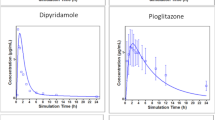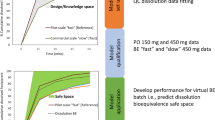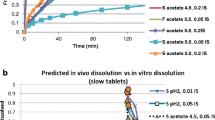Abstract
This study explored the utility of mechanistic absorption models to describe the in vivo performance of a low solubility/low permeability compound in normal healthy subjects. Sixteen healthy human volunteers received three oral formulations and an intravenous infusion in a randomized crossover design. Plasma ciprofloxacin concentrations were estimated by HPLC. In vitro ciprofloxacin release from the oral tablets was tested under a variety of conditions. A mechanistic model was used to explore in vivo dissolution and intestinal absorption. Although dissolution rate influenced the location of drug release, absorption challenges appeared to be associated with permeability limitations in the lower small intestine and colon. The apparent relationship between drug solubilization within the upper small intestinal and formulation overall bioavailability suggested the presence of an intestinal absorption window in many individuals. Failure to absorb drug within this window appeared to be linked with the likelihood of in vivo drug precipitation. Challenges encountered during this modeling exercise included large intersubject variability in product in vivo dissolution and the apparent limitations in ciprofloxacin absorption. Although transporter activity was not included as a model parameter, this evaluation demonstrated how identifying the location of drug absorption across several formulations provided an opportunity to identify factors to consider when formulating similar low solubility/low permeability compounds. The use of mechanistic models was invaluable for our understanding of in vivo product performance and for the assessment of individual profiles rather than means. The latter was essential for understanding the potential challenges that may be encountered when introducing a formulation into a patient population.








Similar content being viewed by others
References
Zhang H, Xia B, Sheng J, Heimbach T, Lin TH, He H, et al. Application of physiologically based absorption modeling to formulation development of a low solubility, low permeability weak base: mechanistic investigation of food effect. AAPS PharmSciTech. 2014;15:400–6.
Jamei M, Turner D, Yang J, Neuhoff S, Polak S, Rostami-Hodjegan A, et al. Population-based mechanistic prediction of oral drug absorption. AAPS J. 2009;11:225–37.
Sjögren E, Abrahamsson B, Augustijns P, Becker D, Bolger MB, Brewster M, et al. In vivo methods for drug absorption - comparative physiologies, model selection, correlations with in vitro methods (IVIVC), and applications for formulation/API/excipient characterization including food effects. Eur J Pharm Sci. 2014;57:99–151.
Olivera ME, Manzo RH, Junginger HE, Midha KK, Shah VP, Stavchansky S, et al. Biowaiver monographs for immediate release solid oral dosage forms: ciprofloxacin hydrochloride. J Pharm Sci. 2011;100:22–33.
Merck Manual http://www.merck.com/product/usa/pi_circulars/c/cipro/ciproIV_pi.pdf Accessed 06/04/2015.
Fahmy R, Kona R, Dandu R, Xie W, Claycamp G, Hoag SW. Quality by design I: application of failure mode effect analysis (FMEA) and Plackett-Burman design of experiments in the identification of “main factors” in the formulation and process design space for roller-compacted ciprofloxacin hydrochloride immediate-release tablets. AAPS PharmSciTech. 2012;13:1243–54.
Claycamp HG, Fahmy R, Kona R, Hoag SW. Quality-by-design II: application of quantitative risk analysis to the formulation of ciprofloxacin tablets. AAPS PharmSciTech. 2015 Jul;23 (epub ahead of print).
Kona R, Fahmy RM, Claycamp G, Polli JE, Martinez M, Hoag SW. Quality-by-design III: application of near-infrared spectroscopy to monitor roller compaction in-process and product quality attributes of immediate release tablets. AAPS PharmSciTech. 2015;16:202–16.
Tissue BM (2009). Basics of Analytical Chemistry and Chemical Equilibria. http://www.tissuegroup.chem.vt.edu/a-text/spreadsheets.html Accessed 06/08/ 2015.
SimulationsPlus science + Software = Success (2015). http://www.simulations-plus.com/ Accessed 06/08/2015.
Parrott N, Lukacova V, Fraczkiewicz G, Bolger MB. Predicting pharmacokinetics of drugs using physiologically based modeling--application to food effects. AAPS J. 2009;11:45–53.
Arakawa H, Shirasaka Y, Haga M, Nakanishi T, Tamai I. Active intestinal absorption of fluoroquinolone antibacterial agent ciprofloxacin by organic anion transporting polypeptide, Oatp1a5. Biopharm Drug Dispos. 2012;33:332–41.
Haslam IS, Wright JA, O’Reilly DA, Sherlock DJ, Coleman T, Simmons NL. Intestinal ciprofloxacin efflux: the role of breast cancer resistance protein (ABCG2). Drug Metab Dispos. 2011;39:2321–8.
Agoram B, Woltosz WS, Bolger MB. Predicting the impact of physiological and biochemical processes on oral drug bioavailability. Adv Drug Deliv Rev. 2001;50 Suppl 1:S41–67.
Lu ATK, Frisella ME, Johnson KC. Dissolution modeling: factors affecting the dissolution rates of polydisperse powders. Pharm Res. 1993;10:1308–14.
Mithani SD, Bakatselou V, TenHoor CN, Dressman JB. Estimation of the increase in solubility of drugs as a function of bile salt concentration. Pharm Res. 1996;13:163–7.
Sleno L, Volmer DA. Assessing the properties of internal standards for quantitative matrix-assisted laser desorption/ionization mass spectrometry of small molecules. Rapid Commun Mass Spectrom. 2006;20:1517–24.
Yu X, Zipp GL, Davidson 3rd GW. The effect of temperature and pH on the solubility of quinolone compounds: estimation of heat of fusion. Pharm Res. 1994;11:522–7.
Jakubiak P, Wagner B, Grimm HP, Petrig-Schaffland J, Schuler F, Alvarez-Sánchez R. Development of a unified dissolution and precipitation modeland its use for the prediction of oral drug absorption. Mol Pharm. 2016 Jan 5. [Epub ahead of print].
Harder S, Fuhr U, Beermann D, Staib AH. Ciprofloxacin absorption in different regions of the human gastrointestinal tract. Investigations with the hf-capsule. Br J Clin Pharmacol. 1990;30:35–9.
Washington CB, Hou SY, Campanella C, Hughes N, Brown S, Berner B. Pharmacokinetics and pharmacodynamics of a novel extended-release ciprofloxacin in healthy volunteers. J Clin Pharmacol. 2005;45:1236–44.
Gubbins PO, Bertch KE. Drug absorption in gastrointestinal disease and surgery. Clinical pharmacokinetic and therapeutic implications. Clin Pharmacokinet. 1991;21:431–47.
Tran TH, Smith C, Mangione RA. Drug absorption in celiac disease. Am J Health Syst Pharm. 2013;70:2199–206.
Parsons RL. Drug absorption in gastrointestinal disease with particular reference to malabsorption syndromes. Clin Pharmacokinet. 1977;2:45–60.
Author information
Authors and Affiliations
Corresponding author
Additional information
Guest Editors: Amin Rostami Hodjegan and Marilyn N. Martinez
Rights and permissions
About this article
Cite this article
Martinez, M., Mistry, B., Lukacova, V. et al. Use of Modeling and Simulation Tools for Understanding the Impact of Formulation on the Absorption of a Low Solubility Compound: Ciprofloxacin. AAPS J 18, 886–897 (2016). https://doi.org/10.1208/s12248-016-9913-2
Received:
Accepted:
Published:
Issue Date:
DOI: https://doi.org/10.1208/s12248-016-9913-2




